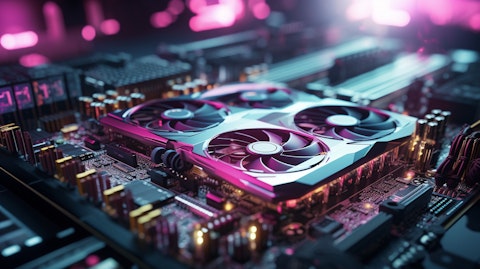We recently published a list of 8 High Growth High Margin Stocks to Invest In Now. In this article, we are going to take a look at where NVIDIA Corporation (NASDAQ:NVDA) stands against other high growth high market stocks to invest in.
How Market Trends Shape Opportunities
When investor confidence is high, capital tends to flow into growth sectors, driving up stock prices and valuations. This is particularly relevant for companies with strong growth prospects and high margins, as they are often seen as more resilient in a recovering economy. Current market dynamics indicate that much of the upward movement may be attributed to multiple expansions rather than just earnings growth. High-growth stocks typically trade at higher price-to-earnings ratios, so if the market continues to expand, these stocks could benefit significantly as investors are willing to pay a premium for growth potential.
Jason Trennert, Strategas Research Partners chairman and CEO, joined CNBC’s ‘Squawk Box’ on October 3 to discuss the latest market trends and the state of the economy, highlighting that the bar is high to get bearish now.
Jason Trennert revealed that he turned bullish at the end of 2023 after initially predicting a recession. Despite the challenges of 2022 and early 2023, which made it difficult to envision a market recovery, he noted that the market has defied expectations and continued to rise. Trennert attributed a significant portion of this upward movement to multiple expansions rather than just earnings growth. He marked a pivotal moment in 2023 as the failure of Silicon Valley Bank, which led to increased liquidity in the market and a subsequent rally. He recalled that around eleven months ago, the S&P 500 briefly hit 4,100 when ten-year yields reached 5%, suggesting that market dynamics have shifted considerably since then.
When discussing current valuations, Trennert pointed out that the market is trading at approximately 22 times earnings during an easing cycle. He expressed skepticism about future earnings growth, as expectations for a 14% increase in S&P earnings next year seem inconsistent with the anticipated six rate cuts from the Fed. He emphasized that if the market is expecting such significant easing while also projecting strong earnings growth, there may be a disconnect.
Trennert also addressed concerns regarding government spending and deficits, noting that the federal deficit has reached 7% of GDP and expressing a desire for more free-market-oriented policies rather than gridlock in Washington. He criticized both parties for their lack of commitment to reducing deficits and highlighted the moral hazard created by prolonged quantitative easing over the past 12 years. He believes that this situation has led to irresponsible spending practices that will eventually necessitate accountability. Despite these concerns, Trennert acknowledged that it is challenging to adopt a bearish outlook given current market conditions. He noted that ten-year treasury yields above 4.5% typically lead to market indigestion, while yields below this threshold make it hard to remain pessimistic.
As for small-cap stocks, Trennert pointed out that they have historically been underrepresented in portfolios and may offer opportunities for future growth. He highlighted that many venture capital-backed firms are looking to go public, with approximately 45% of them potentially tapping into the IPO market at some point. However, he cautioned that if the economy continues to slow down and earnings growth expectations are not met, small caps may struggle.
Skepticism about the projected earnings growth for the S&P 500 could also apply to high-growth stocks. If expectations for earnings growth are too optimistic relative to economic conditions, such as anticipated rate cuts, it may lead to volatility in high-growth stocks, especially if actual earnings do not meet these elevated expectations. Companies with high-profit margins are generally better positioned to weather economic downturns. As Trennert noted concerns regarding government spending and deficits, firms that maintain or improve their profit margins may be more attractive to investors seeking stability amidst economic uncertainty.
Trennert’s overall analysis underscores the importance of monitoring government policies and economic indicators as they influence investor sentiment and market performance moving forward. Still, his predominantly bullish sentiment lays the groundwork for a lot of investors, and to make the portfolio expansion process even easier for them, we’re here with a list of the 8 high growth high margin stocks to invest in now.
Methodology
We sifted through Finviz to compile an initial list of the top stocks. From that list, we narrowed our choices to 15 companies with TTM net profit margin above 20% and 5-year net income compound annual growth rates above 25%. We then selected the 8 stocks that were the most popular among elite hedge funds and that analysts were bullish on. The stocks are ranked in ascending order of the number of hedge funds that have stakes in them, as of Q2 2024.
Why are we interested in the stocks that hedge funds pile into? The reason is simple: our research has shown that we can outperform the market by imitating the top stock picks of the best hedge funds. Our quarterly newsletter’s strategy selects 14 small-cap and large-cap stocks every quarter and has returned 275% since May 2014, beating its benchmark by 150 percentage points (see more details here).

A close-up of a colorful high-end graphics card being plugged in to a gaming computer.
NVIDIA Corp. (NASDAQ:NVDA)
5-Year Net Income CAGR: 56.73%
TTM Net Profit Margin: 55.04%
Number of Hedge Fund Holders: 179
NVIDIA Corp. (NASDAQ:NVDA) is the pioneer of GPU-accelerated computing, specializing in products and platforms for the large, growing markets of gaming, professional visualization, data center, and automotive. Its GPUs have been instrumental in driving advancements in various fields, including deep learning, autonomous vehicles, and virtual reality.
NetApp has launched a new AI tool utilizing NVIDIA technology. Elon Musk’s xAI is leveraging 100,000 NVIDIA H100 GPUs for its AI project, Colossal, with potential future expansion to include H200 GPUs and Blackwell chips.
NVIDIA Corp. (NASDAQ:NVDA) has formed a strategic partnership with Accenture to accelerate AI innovation. Its AI chip, Blackwell, is now in mass production and experiencing high demand. A partnership with Salesforce is established to enhance businesses’ utilization of AI and data. In September, the company introduced Aerial, an AI tool designed to optimize wireless networks for various devices. Its proprietary software, CUDA, provides a competitive edge. The company’s continued success hinges on its ability to sustain innovation and monetize AI effectively.
The company’s CEO believes its competitive advantage in AI chips is sustainable. Snowflake, a cloud data warehousing company, that utilizes Nvidia’s AI Enterprise software to integrate NeMo Retriever microservices into its Snowflake Cortex AI, has seen its stock price rise 10% in the past month due to strong prospects driven by a strong portfolio and expanding partner base.
The recent earnings beat, upwardly revised guidance, and upward stock movement all point to a potential continued upward trajectory. Investors may want to consider adding NVIDIA Corp. (NASDAQ:NVDA) to their watchlist or portfolios given its positive momentum.
Vltava Fund stated the following regarding NVIDIA Corporation (NASDAQ:NVDA) in its Q3 2024 investor letter:
“Over the summer, we devoted a lot of time to studying the AI-related investment wave. This spans a wide range of sectors and our view could be very briefly summarised as follows: The first-tier beneficiaries are primarily companies in the semiconductor sector, NVIDIA Corporation (NASDAQ:NVDA) perhaps the most. That company is benefiting from the huge increase in investment by large technology companies to build enormous data centres. We know who NVIDIA’s customers are. They are companies like Meta, Alphabet, Amazon, and Microsoft. They are investing hundreds of billions of dollars into their AI capabilities. What is not entirely clear, however, is who are and will be the customers of NVIDIA’s customers, and, more importantly, when, and if, they will be able to come up with such huge demand for AI services that the profits from AI will justify and pay for the enormous investments all these companies have been making. The further we move away from the starting point that NVIDIA represents in our more broadly-reaching estimates, the lessreliable those estimates are.So far, we know just one thing for sure, and that is that investments in AI capabilities are ongoing and they are huge. They are not only bringing large demand to chipmakers and the semiconductor sector but to some other sectors as well. Indeed, building AI clusters also requires the construction of new semiconductor factories, new energy sources, and all the associated infrastructure. The numbers under consideration are incredibly high. It is possible that over the next decade the construction of AI centres will necessitate a 20% increase in US energy consumption. The investment required will be measured not in the hundreds of billions of dollars, but in an order of magnitude higher. Maybe two orders of magnitude.”
Overall, NVDA ranks 1st on our list of high growth high market stocks to invest in. While we acknowledge the growth potential of NVDA as an investment, our conviction lies in the belief that AI stocks hold great promise for delivering high returns and doing so within a shorter timeframe. If you are looking for an AI stock that is more promising than NVDA but that trades at less than 5 times its earnings, check out our report about the cheapest AI stock.
READ NEXT: $30 Trillion Opportunity: 15 Best Humanoid Robot Stocks to Buy According to Morgan Stanley and Jim Cramer Says NVIDIA ‘Has Become A Wasteland’.
Disclosure: None. This article is originally published at Insider Monkey.





